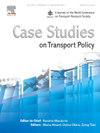The effects of urban form on public transportation demand in a developing city
IF 2.4
Q3 TRANSPORTATION
引用次数: 0
Abstract
Rapid urban growth in developing cities alters urban form, which directly and indirectly impacts access to public transit. Therefore, to accurately predict future public transit usage in order to achieve a sustainable public transportation system, it is essential to understand how each urban form indicator influences demand. However, most previous research has focused primarily on the Global North or China. Therefore, this study aims to fill that gap by analyzing the effects of urban elements on public transportation demand in a developing city. To do so, after a comprehensive review of relevant studies, effective elements of urban form were identified. Then, using spatial statistical analysis, a database of the urban form and travel characteristics was assembled, and random forest regression was employed to examine the relationship of different urban form indicators with public transit usage. The model achieved a good fit and, using a game-theoretic interpretability technique revealed that most variables had consistent associations with the findings from studies in other parts of the world. However, a few variables exhibited different associations, such as distance to educational land use. Additionally, some variables had opposite associations depending on whether they were at the origin or destination of the trip, such as distance from the city center. Therefore, it is concluded that the impact of each factor on public transportation demand should be evaluated on a case-by-case and an origin–destination basis.
发展中城市形态对公共交通需求的影响
发展中城市的快速发展改变了城市形态,直接或间接地影响了公共交通的可及性。因此,为了准确预测未来的公共交通使用情况,以实现可持续的公共交通系统,了解每个城市形态指标如何影响需求是至关重要的。然而,大多数先前的研究主要集中在全球北方或中国。因此,本研究旨在通过分析城市要素对发展中城市公共交通需求的影响来填补这一空白。为此,在对相关研究进行全面审查后,确定了城市形态的有效要素。在此基础上,运用空间统计分析方法,构建了城市形态与出行特征数据库,并采用随机森林回归分析了不同城市形态指标与公共交通使用的关系。该模型获得了很好的拟合,并且使用博弈论的可解释性技术揭示了大多数变量与世界其他地区的研究结果具有一致的关联。然而,一些变量表现出不同的关联,例如到教育用地的距离。此外,一些变量有相反的关联,这取决于他们是在旅行的起点还是目的地,比如离市中心的距离。因此,得出的结论是,每个因素对公共交通需求的影响应在个案和出发地基础上进行评估。
本文章由计算机程序翻译,如有差异,请以英文原文为准。
求助全文
约1分钟内获得全文
求助全文

 求助内容:
求助内容: 应助结果提醒方式:
应助结果提醒方式:


